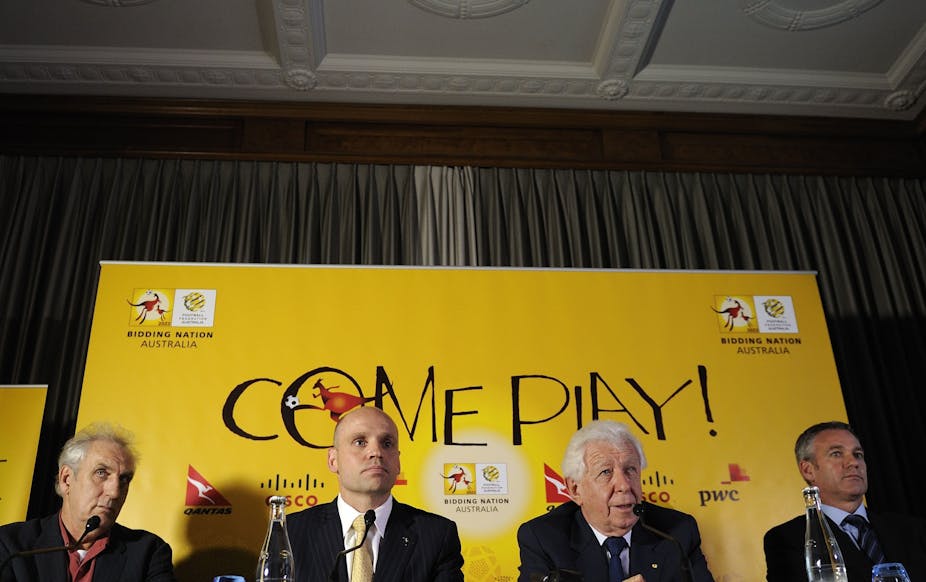BUSINESS OF SPORT: Australian taxpayers are right to question government spending. For example, we have recently seen debate over policies such as the National Broadband Network and the Home Insulation Scheme.
This type of questioning is important - it rightly forces governments to justify their actions in terms of public benefits.
However, taxpayers do not seem to be so ready to question large sums of public money being spent on sport.
Much of the funding is spent building stadiums and bidding for and staging mega-events. In Australia, governments have paid ⎯ or have set aside ⎯ over $2 Billion for the construction of stadiums since 2000. Recently, a bid of $45 million was made to win the rights to host the FIFA World Cup.
This is surprising. All of the activities associated with these subsidies yield private profits for stakeholders. The public benefits are unclear, and the spending carries significant opportunity costs.
To begin, we must first ask why it is that governments subsidise anything. The basic answer is that for some goods and services, private markets will not capture all of the benefits arising from production or consumption.
Hence, we get less output produced than is socially desirable.
Economists call these uncaptured benefits ‘positive externalities’. There are many examples. When we get a flu shot for example, we tend to think more about the benefits to ourselves of immunity and not of preventing transmission to others.
When we send our children to school, we think about the private benefits of their education, not the concept of building a smarter and more productive Australia. Many of these types of activity appropriately receive subsidies from government.
Government spending on sport, like any other sector, should also pass the ‘positive externality’ test. There are three main reasons which may justify government involvement.
The first is that participation in sport carries health benefits. The second is that there are spill-over benefits to the economy. The third, related argument is that these things ‘put us on the map’.
There is little doubt that playing sport brings health benefits. However, there are genuine concerns over whether these types of subsidies are the best way to increase participation.
In fact, the growth in the size of TV rights deals for top tier sports tend to suggest that we may be doing the opposite – generating more viewing and less playing.
Young people in particular may be inspired by a famous World Cup victory, or achievement by one of our athletes at the Olympics, but they also benefit from having access to local sporting facilities or having sports equipment at school.
Arguably, these are the types of activity which warrant the receipt of government funding, especially as football teams and Olympic athletes are unlikely to disappear if we stop subsidising them.
The second reason is that there are spill-over benefits to the economy. It is however an unfortunate statistic that, almost without exception, studies that forecast the economic benefits of stadium construction and mega-events prior to that event predict large gains, and studies which evaluate the benefits after the fact reveal losses, or at best modest gains. Examples from a long list include the Sydney Olympics and the 2006 World Cup in Germany.
To see why, consider the staging of an F1 Grand Prix. When this is held, there is likely to be an increase in spending. Some of this is from tourists and some from local citizens. The ‘increases’ in spending from the latter group will generally come at the expense of spending in another sector of the economy.
People have budgets, so $200 spent on a day at the Grand Prix is $200 less to spend elsewhere in the economy. The same argument holds for tourists who would have come to the city anyway. For tourists who genuinely visit solely for the Grand Prix, this is a gain for the economy, but unfortunately, all three groups are included in economic impact studies.
Moreover, the latter category of new spenders tends to be overestimated. One example documented by a US economist, Victor Matheson, involved an estimate of 100,000 visitors to Denver for a single NBA game, despite the fact that the stadium and hotel capacity were 20,000 and 6000 respectively.
A similar argument holds for the activity generated by construction. All resources, including labour, tend to be drawn from other parts of the economy – if bricklayers are diverted to building a stadium, then this means fewer are available to build houses.
The problem of estimating gains is even worse in the case of mega-event bidding. Here, public money is spent for the chance of hosting. Given that corruption scandals have rocked the IOC and more recently FIFA, we should be seriously questioning what public benefit could possibly arise from being involved in such a process.
There are beneficiaries to all of this however. Most grounds are built to host professional team sports, which yield the majority of gate receipts and associated TV rights deals. Indeed, in an industry which should be otherwise profitable, it is hard to see why the public should fund these stadiums anymore than they would fund the construction of a new department store.
Organisations like the IOC and FIFA collect large sums from the staging of their events and incur few costs. Again, the realisation of these profits suggests that incentives exist to stage these events without subsidies.
Sport in Australia is something we should be proud of. We have a strong tradition and are a nation of keen players and followers. However, that does not necessarily imply that it warrants the type of funding we typically see from our governments.
The ‘externalities’ which justify public funding may be there, but there is rarely a robust public debate about their validity and the supporting evidence appears to be weak.
The strongest benefits are probably centred around encouraging participation in sport but there are a great number of ways in which government money could be spent more directly on this.

